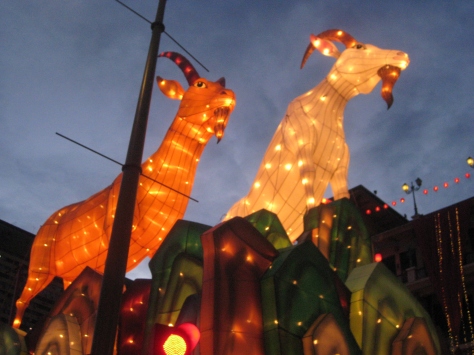
It is my nature that on festival days, I feel very restless at home. It doesn’t matter whether it’s traditionally a festival I’ve followed for years or a festival I’ve just been immersed in due to the accident of location or company but there is that smell in the air and that sparkle in the light around that just does not let me stay at home while the city decks itself in lights, crowds and festivities.
And so it has been with Chinese New Year this year.
So on Thursday, armed with a guidebook that says SINGAPORE in large letters on the cover, I get to the train station in the afternoon determined to reach Chinatown. I carefully tuck the guidebook away in my bag because I hate to have people think I’m a tourist.
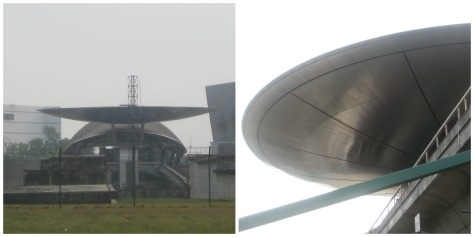
Before the long weekend for the Chinese New Year starts, several people already warn me that I should stock up on groceries because “Chinese New Year is like Thanksgiving in the US. All restaurants and stores will be closed. Make sure you buy some groceries.”
The streets had indeed seemed empty when I had paid a visit to the local mall to eat on Wednesday evening, a place which is always throbbing with life but was shrouded in an unnatural, quiet stillness with most shops and food kiosks closed. No exhibitions inside the mall, no crowds on the giant escalators, no salespeople standing on stools hawking smartphones.
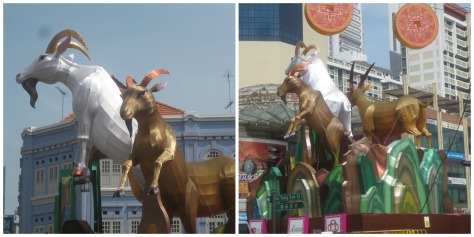
On my way to the station though, I am derailed by a bridal exhibition being held in one of the great halls at Expo, next to the station. It is an array of gorgeous Indonesian and Malaysian bridal gowns and head scarves for men and women with very intricate embroidery and bright colours.
I stop to look at one and a saleswoman approaches me in very polished, standard English. I tell her that I am just looking around and she returns to her stool. I wander towards the back of the hall attracted by fascinating aromas of food, a very rare juxtaposition in similar exhibitions in other places, and discover an array of kiosks of Malaysian, Indonesian and Indian dishes.
I’m curious as I try to “read” the names of the dishes. They are all in “English” ie. the Latin alphabet, but other than the names of the Indian dishes, I am unable to make out what each dish is, especially the delectable ones that seem wrapped in leaves and roasted and sold as fast food.
I tarry but I also have to go, to see the New Year celebrations and so I hurry back to the station to catch the Green Line. But even as I think I shouldn’t tarry, I remember a comment by an American colleague (who reads my writing) who says, “There’s something very Indian about your English. I don’t know what.” I also think of a comment by my American friend on some of her Singaporean student papers: “There’s something very British about their English. Also Singaporean.”
I only know that I may have been somehow tarrying at the bridal exhibition because of a Scottish ballad in my middle school English book: “A Chieftain to the Highlands bound,/Cries, ‘Boatman, do not tarry;/ And I’ll give thee a silver pound/ To row us o’er the ferry.” Something that came up in my mind, maybe because of the poetic nature of all this gorgeousness around and the train station which needs the tap of a card, if not a silver pound, to carry me everytime. Tap in and tap out or get fined.
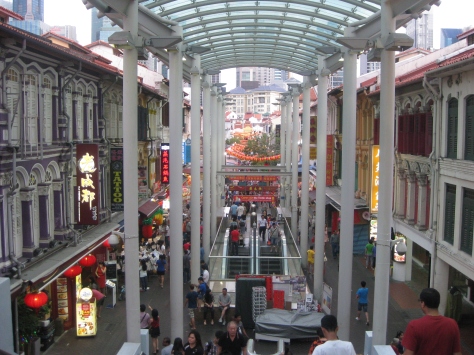
The trains here seem newer and swankier than other subways that I have seen in other cities. The displays on the walls of the compartments lighting up the different stations (as we are about to reach them) always work without fail.
The woman’s voice announcing the stations (with the British accent) on the speaker is crystal clear, sometimes telling you to cross over to the middle platform to catch the train to Changi airport or to tell you that the train service will end at Pasir Ris. Her pronunciation is always the same, the word stress always follows the rules of good, standard English and thus we pass Bedok, Kembangan, Eunos, Kallang, Lavender, Tanjong Pagar, Commonwealth and many other names that all match the same phonology of English regardless of the language the names originated in. (In some stations though, I hear announcements in up to four languages but I do not understand any of the ones that is not English. I suddenly note that the voice seems to get softer in one language compared to the others and realize it’s a tone that my ears are not trained to hear.)
I sometimes look up the brief histories of the different locations on the internet or on placards on the road I occasionally come across that are ignored by most busy people. Aljuneid, I learn, is named after an Arab merchant from the early twentieth century who had migrated from Yemen. I was in Bugis yesterday and a placard there told me that the Bugis, a seafaring people from the South Sulawesi province of Indonesia used to sail via canals that existed before the British came here to trade with Singaporean merchants. According to later paintings, they were aggressive and warlike and had subdued many of the people in surrounding areas until they were, in turn, subdued by the British. The English word bogeyman may have originated from these “ruthless” seafarers who prowled the Straits, the “pirates” who often attacked British and Dutch trading ships.
I know I have to get off at Outram Park. [I learn, from The Voice, that the name ought to be pronounced Oootram Park and not as starting with the word “out.” For many years, I had indeed pronounced that name “wrongly” then, I realized, as we have our own Outram Ghat in Calcutta (now Kolkata) presumably named after the same nineteenth-century British general who fought in the Indian Rebellion of 1857. There is a Ghat in Singapore too, close to Little India, a place called Dhoby Ghaut. The Voice pronounces Dhoby Ghaut expertly, minus the aspirated consonants absent in English, as “Dobby Got” {which again makes me think of the rather helpful and endearing elf from Harry Potter instead of the river bank full of washermen as Dhoby (laundryman) in Hindi, Punjabi and Tamil and Ghat (bank of a water body, also in my own native Bengali) implied.}]
The Voice is really convenient for standardization because it is clear, matching each lighted dot that changes from green to red as we approach each station. Every one of the stations also has an alpha-numeric code attached to it signifying the subway line and the station number written in the colour code it is a part of (a code also taken up by Google Maps, I see, for convenience. )
I get off at Outram Park to be greeted by festive crowds, thinner than on the previous day but all ready to have fun. The divider in between the roads is festooned with lanterns in the shape of 1500 gold coins that glow like a thousand huge planets in the sky in the dark and 338 goats in various postures grazing or looking up at the sky, each one also a lighted lantern.The weather is balmy, the sun isn’t too strong and I just catch the fascinating sight at dusk when the sky is still tinted with the last rays of sunshine.
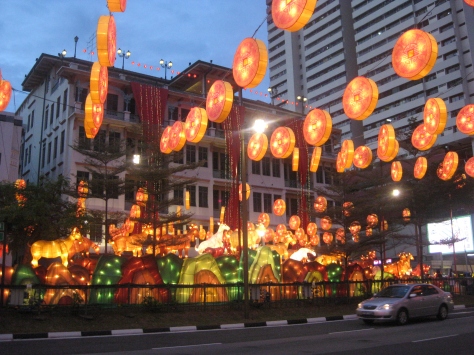
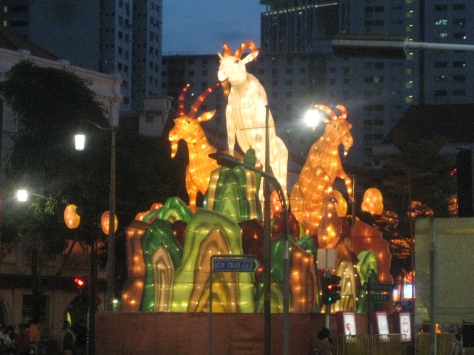
There is food again, everywhere. There are soupy things, stir fried things, dumpling-like things in a hundred avatars and then of course, there is the inimitable Durian—a fruit with a very strong, distinctive smell that you’ll either absolutely love or completely hate, I was told.
As I roam Food Street and the Hawker Centers in Chinatown, so distinctive of Singapore with their great collection of food kiosks, I am faced with the difficulties of translation. Because, of course, soup is a very rough translation of what these vast array of dishes are, and the pancakes are not what their Western counterparts signify but something that only follows the basic principles of definition of the dish as “cakes” cooked in a pan. Sadly, just where the dish defies the definition and becomes wonderful and unique, it cannot be translated.
I try a “pancake.” It is delicious, just like the fried “carrot cake” I had yesterday, a savoury, omlette-like fast food which bears no resemblance to its Western counterpart but is named after a root like a radish, one of its main ingredients, a word which can also refer to a carrot.

Most people in Singapore speak and understand some version of English though, I think, in my very limited experience of the place or can smoothly move between Standard English and Singlish, the English-based creole or patois spoken here. So I am confident of being understood as I walk into a restaurant where a very sweet young girl hands me a menu with pictures and names of dishes written in a language I don’t know (Mandarin or another Chinese vernacular) and “English.”
There is only one dish with an English word I recognize on the menu, Chicken, but the dish looks dry and stir fried and I am attracted to the dish right next to it, which seems soupy and spicy. So I point to the soupy dish and ask chicken or pork?
I say chicken, chicken, chicken a few times but we fail to communicate. The girl is confused for a while and gets a very smartly dressed young man to help. At first I think he has been called because he understands English but soon realize that the girl defers to him because of his confidence, not expertise.
The young man looks at the dish and points to his mouth in a fanning movement, guessing at what I am asking. “Hoooo-haa–hooo-haa” he goes a couple of times and I realize he is warning me that the dish is spicy.
Now, I am not afraid of spicy in the least but I do want my chicken.
I do not give up and continue gesticulating until I reach the point of showing flapping wings but am at a loss as to how to depict pork without resorting to actions completely not befitting a classy place such as this when we all become conscious of the fact that other diners are staring at us. Embarrassed, I point to the chicken dish with the only English word I can see in my English, not his.
The young man brings me the dish. It looks very appetizing with cubes of chicken, very green slices of medium large peppers and carrots in a dark sauce. He also brings me a pair of bright orange chopsticks.
Now I am at a loss again because despite some practice, I am yet to pick up enough expertise to complete a whole meal using chopsticks. Usually, in most places so far, if I have pointed downwards using three fingers and used the word “fork” loud and clear, I have got either a fork or a spoon. Being Indian, I can, of course, eat very expertly with my hands but for some reason this is not seen as polite even in India anymore in public and so I refrain from doing so. I make my fork gesture but I also have to gesture for rice, and I make a cupping sign with both palms to signify a bowl of rice.
It works! The young man brings me a soup spoon in matching bright orange, same as the chopsticks, but also an empty bowl which makes my heart sink. I try one last time making a mound of rice with my hands first and then showing fine finger movements flowing down that could either mean grain or rain but I am desperate.
Thankfully, he takes the empty bowl back and comes back with cooked rice in it. But now, he and I are both embarrassed to “talk.” Yet he hesitates. I guess at the reason for his hesitation to leave and give him a ten dollar bill. He takes it and disappears immediately and never comes back. I realize too late that he has not charged me for the rice.
The food is somewhat spicy. So after dinner, I walk to a bubble tea place which looks very modern and swanky, a little out of place in the Hawker Center around the station I have walked to. The girls prepare my drink expertly and hand me the drink as they ask me something, in Mandarin or in another vernacular of Chinese. I know I look very Indian but that many ethnic Indians here speak fluent Mandarin apart from Tamil and several other languages too. And I am quite ignorant of all of the above. But this time, I can guess what they are saying: “Do you need a palstic bag?”
I didn’t need a plastic bag, not really, but nodding vigorously is far easier than shaking your head from side to side to say no. So they seal my bubble tea and drop it in a bag and hand it to me as I head back towards Outram Park.
As I walk past the Durian confectionery store and the Mc Donalds and the KFC and the many smartphone stores, I wonder if it was really the Year of the Goat I had entered or if it was the Year of the Sheep (both, surely, can’t be the same) or if it was the year of some other interesting animal, a close cousin of both but badly lost in translation for me.
Gong Xi Fa Cai!
Afternote: Ahh, I wasn’t wondering in vain. Goat or sheep or ram? There seems to be a scholarly controversy indeed about the horned animal!

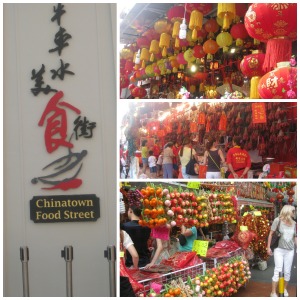
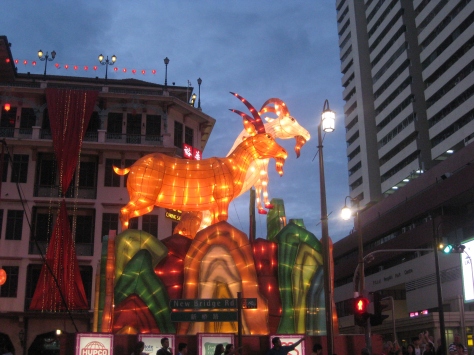
thank,s
LikeLike
i like it
LikeLike
Great post. Maybe next time i must try to trip on Singapore.
LikeLike
Great post, i want to planning this trip year..
LikeLike
good job
LikeLiked by 1 person
its interesting for next adventure…
i think this like in Indonesia full of cultural diversity and the arts that is a symbol of a country
LikeLiked by 1 person
the road is very exciting, a lot of cultural diversity can be seen and a lot of new experiences
LikeLike
It is very interesting and is a nice picture. I am new in this. i have a new blog called #fuertessiempre i need people see it because is very interesting. I am sorry if i am writying bad in english so i am spanish. Sorry and thank you very much.
LikeLike
nice post, thank’s for sharing.
LikeLike
Thank you for sharing your experience through this article is probably in the days to come on while on vacation to singapore during the chinese new year so I know the situation is
LikeLiked by 1 person
I think that experience is interesting , unique and funny
LikeLike
sometimes the quality of people we can see from the many good aspects of it through writing or otherwise, thanks for writing congratulations write back
LikeLiked by 1 person
How nice it would be to experience Chinese New Year with the people who really celebrate it! =)
LikeLiked by 1 person
I have always admired your wonderful style of writing…you have that magical knack of presenting thoughts in such lucidity and fluidity…this is no exception. The minute observation that you have captured during your journey (woman’s voice announcing the station) and the food streets are so fascinating…
Your thoughts are deep and when articulated it reflects that depth and the diversity of your experience…it is anchoring and enabling for the readers to keep wanting for more…
Thanks for sharing with us such beautiful thoughts…
LikeLike
Thanks for reading so closely. All this stuff really happened. I just recorded them.
LikeLiked by 1 person
That’s perhaps your modesty, this humility reflects in your thoughts and such high quality of writing…
Thanks so much for sharing your lovely ideas…
Have a great weekend…
LikeLike
Bloody awesome
LikeLiked by 1 person
Nice picts and nice adventure!
LikeLiked by 1 person
Reblogged this on oshriradhekrishnabole.
LikeLike
Great post. We are planning a trip that includes Singapore next year so the information is very helpful. Thanks for the post!
LikeLiked by 1 person